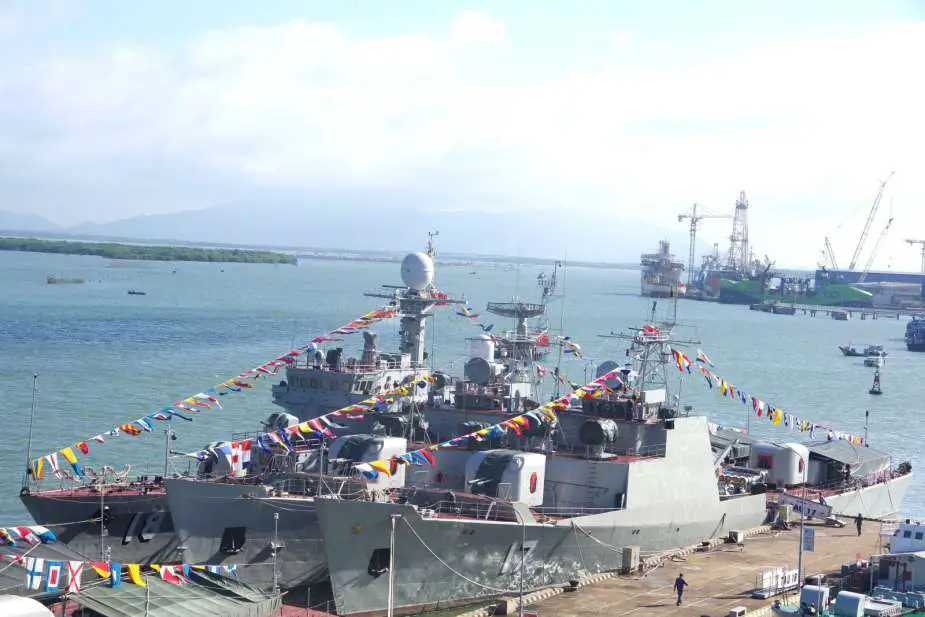Breaking news
Vietnam Navy completes upgrades on Petya II-class frigates.
According to an article from the Asia Pacific Defense Journal on August 22, 2023, recent images confirm that the Vietnam People's Navy has finalized the rehabilitation and upgrade efforts on two Project 159 Petya II-class light frigates, namely the HQ-09 and HQ-17. This development takes place against the backdrop of increased geopolitical tensions in the South China Sea, with particular attention to the situation involving China.
Follow Navy Recognition on Google News at this link
 The two newly upgraded Petya II-class frigates, together with a VPN's Pohang-class corvette (Picture source: Vietnam Defence)
The two newly upgraded Petya II-class frigates, together with a VPN's Pohang-class corvette (Picture source: Vietnam Defence)
The comprehensive modernization work on the two frigates commenced in 2020 at the Song Thu Corporation, a state-owned shipbuilding entity located in Da Nang. Images available online display a revitalized superstructure, which incorporates a modernized bridge design, enhancing the overall aesthetic of the ships. Furthermore, the frigates' electrical and mechanical systems have undergone thorough revamping, with outdated components from the Soviet era replaced by contemporary alternatives that are more readily accessible. While the core armament setup seems unchanged, there are indications of essential repairs also taking place. Unverified reports hint at potential improvements in the ships' electronics and sensor suites, possibly encompassing upgrades to navigation, radar, communication, and bridge systems.
The Project 159 Petya II-class light frigates have held a significant role within the Vietnam People’s Navy (VPN). Initially deployed mainly for anti-submarine warfare and naval patrol tasks, these vessels once formed a central part of the VPN's defense strategy. Over time, their prominence has slightly diminished as more advanced vessels were integrated into the naval fleet over the past decade, such as the Russian Gepard-class guided missile frigates and refurbished Pohang-class corvettes from South Korea. Nonetheless, the recent improvements to the Petya II-class frigates underscore their sustained significance within Vietnam's broader naval strategy.
The Project 159 Petya II-class frigates, known by their NATO reporting name, were conceived in the 1950s and constructed for the Soviet Navy during the 1960s. They were notably the first ships in the Soviet fleet to be powered by gas turbines. These frigates were primarily designed for anti-submarine warfare operations in shallow waters, with key specifications including displacement values of 950 tons (standard) and 1,150 tons (full load), along with dimensions such as a length of 81.8 meters, a beam of 9.2 meters, and a draught of 2.9 meters.
Their propulsion system employed a two-shaft CODAG system, with two gas turbines producing 30,000 horsepower and a diesel engine generating 6,000 horsepower. These frigates could achieve speeds of up to 30 knots and had an operational range of 4,870 nautical miles at 10 knots and 450 nautical miles at 30 knots. The frigates were typically manned by a crew of 90 members. Their armament included 76 mm guns, RBU-6000 anti-submarine rocket launchers, and anti-submarine torpedo tubes. They were also equipped with advanced sensor systems such as Radar Don-2, Slim Net, Hawk Screech, and a Herkules hull-mounted & dipping sonar.
Vietnam's decision to enhance its naval capabilities aligns with a period of elevated maritime tensions, particularly in the South China Sea. This region has seen considerable disputes due to overlapping territorial claims involving multiple nations, including Vietnam and China. These conflicts often center around maritime concerns and assertive actions. China's construction of artificial islands and military maneuvers in the South China Sea have prompted concerns among neighboring countries, Vietnam included. In response, Vietnam has taken measures to bolster its maritime capabilities to protect its territorial rights and interests.
Vietnam's response to China's activities includes the upgrading of its naval assets, such as the modernization of frigates like the Petya II-class. This effort aims to protect maritime sovereignty, monitor potential threats, and act as a deterrent against possible aggression. The upgraded frigates, equipped with advanced anti-submarine warfare capabilities, emphasize Vietnam's commitment to safeguarding its maritime domain.
Historical contexts also play a role in shaping this dynamic. Vietnam's history of colonialism and conflicts with external powers, particularly the United States, have influenced its cautious approach to international relations. China's actions in Vietnam's waters touch upon these historical sensitivities, adding complexity to the interactions between the two countries.
Despite notable economic ties between China and Vietnam, with China being a significant investor in Vietnam's economy, Vietnam remains cautious about fully advancing relations with China due to historical sensitivities. This cautious stance is further influenced by the complex geopolitical landscape as the United States and China navigate their differences.
In this intricate situation, Vietnam finds itself at a crossroads. While engaging with both the United States and China due to its strategic location and involvement in maritime disputes, Vietnam seeks to uphold its sovereignty and security. As it deepens its partnership with the US and builds relationships with other nations, Vietnam must carefully navigate its historical relationship with China, balancing economic ties with the imperative to protect its territorial interests.

























